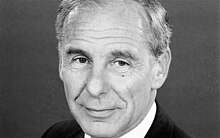Christopher Curwen
Christopher Curwen | |
|---|---|
 | |
| Born | 9 April 1929 |
| Died | 18 December 2013 (aged 84) |
| Nationality | British |
| Alma mater | Sidney Sussex College, Cambridge |
| Occupation | Intelligence officer |
| Awards | KCMG |
| Espionage activity | |
| Allegiance | United Kingdom |
| Service branch | Secret Intelligence Service (SIS/MI6) |
| Rank | Chief of the Secret Intelligence Service |
Sir Christopher Keith Curwen, KCMG (9 April 1929 – 18 December 2013) was a British Intelligence officer specialising in South East Asia who was Head of the Secret Intelligence Service (MI6) from 1985 to 1989.
Career
Curwen was educated at Sherborne School and Sidney Sussex College, Cambridge after which he was commissioned into the 4th Queen's Own Hussars in 1948, serving in Malaya.[1][2] He joined SIS in 1952 and was posted to Thailand in 1954 and Vientiane, Laos in 1956.[2] He returned to the service's London headquarters in 1958, had another spell in Bangkok from 1961 and then two years in Kuala Lumpur. He was at one time married to a woman from Burma;[3] they were later divorced.[4]
Curwen spent three years as SIS liaison officer in Washington D.C. from 1968 and was then head of station in Geneva.[5] He was deputy to Sir Colin Figures from 1980 and succeeded him as Chief of the Service in 1985.[6] His tenure was notable for the successful exfiltration from Moscow of the KGB officer and British agent Oleg Gordievsky.[4][2]
His obituary in The Times noted: "He possessed a romantic patriotism that belied his hard-headed persona."[2]
References
- ^ Burke's Peerage and Gentry
- ^ a b c d "Sir Christopher Curwen obituary". The Times. No. 71078. 27 December 2013.
- ^ "Sir Christopher Curwen". www.thetimes.com. 26 December 2013. Retrieved 9 October 2024.
- ^ a b "Sir Christopher Curwen obituary". The Daily Telegraph. 23 December 2013.
- ^ MI6 - 50 years of Special Operations, by Stephen Dorril, Page 753, Harper Collins, 2001, ISBN 1-85702-701-9
- ^ Cloaked Dagger
Notes
- Sir Christopher Curwen entry in Who's Who
- Curwen entry in the Oxford Dictionary of National Biography
